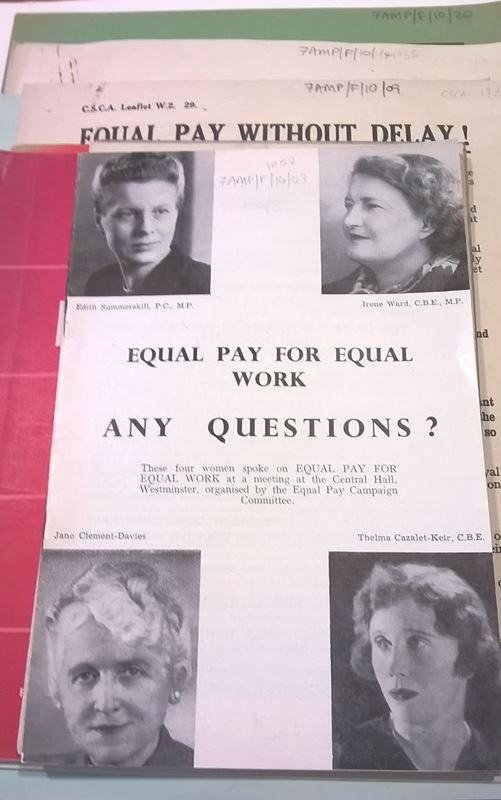‘A home should be the centre of a woman’s life, not its boundary’ (Irene Ward).
Inspired by the research for my paper, Irene Ward, ‘Baroness Ward of North Tyneside (1895-1980) Unorthodox political warrior’ to the Institute of Contemporary British History seminar on 4 October 2015, the intention was to spend most of 2016 exploring further the campaign for equal pay for women, extending the focus beyond Irene Ward, looking more closely at the war-time and early post-war developments culminating in the 1954 act.

Pamphlet published in 1952 by the Equal Pay Campaign Committee. Pierotti papers, the Women’s Library, London School of Economics (LSE), 7 AMP/F/10/09.Miss A Muriel Pierotti was vice-chair of the committee. She also served as secretary of the National Union of Women Teachers. Image reproduced courtesy of the Women’s Library, LSE, University of London.
The first few months of 2016 were spent consulting material in the Women’s Library at LSE. The archive of the Women’s Publicity Planning Association (WPPA) proved particularly fruitful. War time files on the drive to secure ‘Equal compensation for equal danger’ for injured women civilians; nationwide meetings to encourage involvement in politics at local and national levels – the ‘Women for Westminster’ programme; or win greater representation on committees planning post-war reconstruction not only brilliantly illuminated my earlier research, but foregrounded the work of Mavis Tate, MP and Dr Edith Summerskill, MP (and included mention of Honor Balfour), all of whom, had I but known it at the time, would later re-appear in my research into the Astors and twentieth century Cliveden.
Dr Summerskill’s private papers are also in the Women’s Library. Shifting through the archive for information on the equal pay campaign re-ignited my interest in political houses and gardens. In the ‘noughties while exploring my political houses research, discovering that Dr Summerskill (pictured top left in the pamphlet), had commissioned a young woman architect, Elizabeth Benjamin (1908-1999) to work on the family home suggested new possibilities. But after being advised it was (only) an interior remodelling of a Victorian villa, rather than a new build, Melrose, 1 Fitzroy Park, Highgate village, slipped off my list. But here it was again, in February 2016, on the front cover of the July 1935 issue of The Ideal Home; a reproduction of Guy Lipscombe’s delicately coloured painting of the hallway captioned ‘Alterations & improvements’. 1
In an interview with Lynne Walker published in 1996, Elisabeth Benjamin recalled how the scheme had to include dramatic spaces in which Dr Summerskill could make an entrance (the staircase), and entertain (the dining room). The enlarged and reconfigured living room acquired a chic steel fireplace. Five years after the project’s completion war broke out and display receded as an objective. With Dr Summerskill a tireless campaigner on a range of issues, not least promoting women’s equality and political participation, we can only wonder what conversations these spaces absorbed. 2
Notes:
